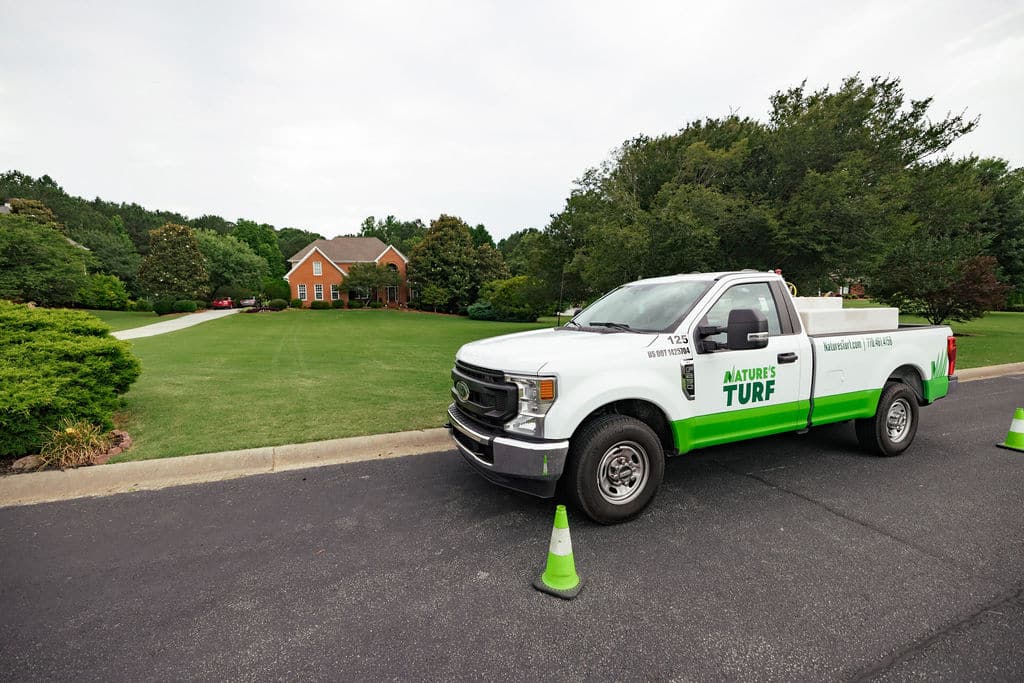Having grown up in metro-Atlanta, only a few minutes from our Fayetteville location of Nature’s Turf, I don’t remember seeing armadillos until 10 years ago or so. Since then, it seems populations have skyrocketed. Most people are accustomed to seeing them as casualties of unintentional roadway skirmishes as they attempt to cross a road or feed on the shoulder, but they are all around us. Just what are these curious little mammals?
What Are Armadillos?
Armadillos are mammals from the same order as anteaters and sloths. While there are many recognized species of varying sizes in Central America, Georgia only has one; the nine-banded armadillo (Dasypus novemcinctus). Males are slightly larger than females, but both are visually similar from the exterior.
Their tell-tale feature is the bony shell plates (called scutes) that form their shell (called a carapace). These scutes are attached via a tough skin layer. As they walk, they flex and hinge as they move. It’s the softer epidermal joints between these scutes that allow this flexibility. Contrary to popular belief or lore, they can’t roll up into a ball, but they still depend on their carapace for protection. They have no prolific natural predators in Georgia.
Environmentally, they don’t prefer temperatures below freezing or above the mid-eighties. While they are documented north of Atlanta, venturing much farther is unlikely. When conditions are unfavorable for foraging, they can be found in their dens. As prolific diggers, they can make their own, or they may opt to use existing dens or holes left vacant. Armadillos don’t store food in these dens, so they must be out when conditions are favorable. Since summer days in Atlanta are often hotter than they’d prefer, their foraging tends to happen at night or in the fringe hours.
How Did Armadillos Get Here?
In a nutshell, they walked and swam. Venturing from Central America into Texas in the ‘30’s, they continued to make their way east. As populations continued to thrive and proliferate, they simply continued moving toward areas where they could survive and thrive. We are experiencing the thrive portion of that paradigm, as we see more and more of them and the damage they create while feeding.
What Do Armadillos Eat?
Armadillos will eat almost anything they can forage for and catch. Research has proven that they aren’t picky eaters, but rather advantageous eaters. While they prefer invertebrates and larvae, a subject we will most certainly circle back to momentarily, they will eat small eggs, small lizards, snakes, fruit, and just about anything else their dull teeth can grind.
Since armadillos have awful eyesite, you’ll often see them seeking prey with their keen sense of smell and hearing. Their erratic walking patterns are often tied to a bunch of sniffing and snorting toward the ground while they seek some of their favorite meals. Occasionally, you may see them stand on their hind legs and sniff before continuing with their search. Since they don’t store food, they almost continually forage while outside of their den.
Why Are Armadillos Tearing My Yard Apart?
One of their preferred meals, and the point where they cross paths with Nature’s Turf and your home lawn, is beetle larvae, otherwise known as white grubs. We receive innumerable calls about armadillo damage, and the general assumption is that they’re rooting for grubs. Truth of the matter, while they love grubs, they’ll also eat all sorts of insects, earthworms, and other sources of sustenance they can find while digging in your turf or yard.
Can Nature’s Turf Help with Armadillos?
We don’t provide wildlife relocation services, but we can help limit their food sources. If you notice rooting damage, or if you catch these little critters in the act, it’s time to find out what they’re looking for. They may even help you identify an underlying turf health issue.
Take a look at where the rooting marks are. Cut a 12”x12” section of sod, and flip it over. Don’t be surprised to see white grubs. All lawns have a few. If you see a lot of them, it may be time to act. At Nature’s Turf, we have a seasonal grub treatment option and a one-time treatment option. We can help you decide which is best for your lawn.
For more information about these treatment options, or to discuss them with your local and friendly lawn care professionals, give us a call at 770-461-4156 or email us at info@naturesturf.com.








